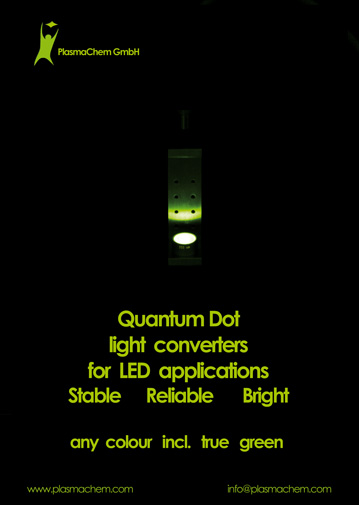Running Projects
Quantum Dots: true green and artificial sun light
 Campfire, touch, candle, incandescent and luminescent lamps – humanity has always been developing more efficient and economic lighting sources, since 500’000 years. The new era of lighting – with light emitting diodes - has become possible with the development of semiconductors and modern methods of their fabrication.
Campfire, touch, candle, incandescent and luminescent lamps – humanity has always been developing more efficient and economic lighting sources, since 500’000 years. The new era of lighting – with light emitting diodes - has become possible with the development of semiconductors and modern methods of their fabrication.
First LEDs (1960-s) were red in colour, had the brightness of 0,001 Lumen and the price of 200 USD. The fast development of technology within next few years allowed to reduce the price per LED to 5 cents and increase the brightness 100-fold – in mid-1970s LEDs were already used widely in digital alphanumerical displays. Within next 30 years the intensity was further increased by 100 times, achieving another breakthrough, which we can evidence today – the “good old” incandescent bulbs are being exchanged to the modern LED light sources. These are bright enough to be used at home, at work, and even at streets and factories. Bright, small and very energy efficient.
But is everything really so perfect about LEDs? Not exactly – LEDs can only produce light of specific wavelengths. In fact one single LED chip is capable of emitting light of only one specific colour. Varying the nature of a semiconductor, you can get blue, red, yellow, red light… Combining many different chips an almost white light can be achieved. However, this “white” light is not exactly white! The reason for this is the absence of semiconductors emitting green light… and not a cyan or turquoise, but the TRUE GREEN light. What is the necessity, you may ask?
True Green Light
The true green light (wavelength of 555 nm) is the one, which is the best viewed by a human eye. The eye can detect one green photon, but can hardly see 100 photons of red or blue “colour”. Green colour is also one of three colours used in each colour-TV set. Also the true green light is the main and most intense component of the sun-light. This is why the most native and natural light is the one emitted by sun, and white LEDs have such unnatural colours. The imitation of sun is the next ambitious target, which has to be achieved by humans at the course of the development of a perfect light source.
What can be done to produce this most valuable component of sun light – the green light? The answer to this is given by nanotechnology. Recently developed tiny semiconductor nanocrystals, called quantum dots, are able of absorbing the light of one wavelength, and emitting the light of another (longer) wavelength. The emitted colour will depend on the size of nanocrystals. One can grow the nanocrystals with the sub-nanometer precision, making them able to emit red, yellow, orange, and also green colour.
So, passing the light of a “standard” blue LED lamp through a converter layer made of quantum dots, one will get a lamp of a predefined colour. The best in this is that one should not change the LED itself for getting different colours – it is enough to change the converters. Combination of several converters, or several quantum dots within one converter can produce the natural light close to that of the sun.
Yet, the big challenge on the way of creating the bright and long-lasting sources of green light, and also of sun light – is making quantum dots stable enough to resist the high intensities of absorbed light without getting modified or oxydized. This could be achieved only recently by a German company PlasmaChem GmbH, which developed a synthesis of special super-stable quantum dots and of a complete converter matrix. Converters produced using this new technology can effectively absorb light of very high intensities and effectively convert it to the light with various wavelengths covering a visible spectrum from yellow to red in 10-nm steps. This opens new horizons for the use of LED technology in everyday life and for the more ecological and energy efficient lighting.
Copyright PlasmaChem GmbH, 2012
Read in German
